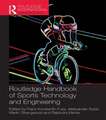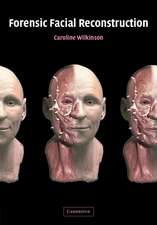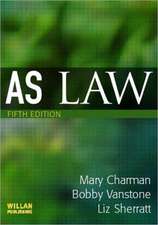Routledge International Handbook of Visual Criminology: Routledge International Handbooks
Editat de Michelle Brown, Eamonn Carrabineen Limba Engleză Hardback – 21 iun 2017
This book is divided into five parts that each highlight a key aspect of visual criminology, exploring the diversity of methods, techniques and theoretical approaches currently shaping the field:
• Part I introduces formative positions in the developments of visual criminology and explores the different disciplines that have contributed to analysing images.
• Part II explores visual representations of crime across film, graphic art, documentary, police photography, press coverage and graffiti and urban aesthetics.
• Part III discusses the relationship of visual criminology to criminal justice institutions like policing, punishment and law.
• Part IV focuses on the distinctive ethical problems posed by the image, reflecting on the historical development, theoretical disputes and methodological issues involved.
• Part V identifies new frameworks and emergent perspectives and reflects upon the distinctive challenges and limits that can be seen in this emerging field.
This book includes a vibrant colour plate section and over a hundred black and white images, breaking down the barriers between original photography and artwork, historic paintings and illustrations and modern comics and films. This interdisciplinary book will be of interest to criminologists, sociologists, visual ethnographers, art historians and those engaged with media studies.
| Toate formatele și edițiile | Preț | Express |
|---|---|---|
| Paperback (1) | 345.16 lei 3-5 săpt. | +35.76 lei 10-14 zile |
| Taylor & Francis – 30 iun 2020 | 345.16 lei 3-5 săpt. | +35.76 lei 10-14 zile |
| Hardback (1) | 1228.00 lei 6-8 săpt. | |
| Taylor & Francis – 21 iun 2017 | 1228.00 lei 6-8 săpt. |
Din seria Routledge International Handbooks
-
 Preț: 371.78 lei
Preț: 371.78 lei -
 Preț: 375.50 lei
Preț: 375.50 lei -
 Preț: 362.19 lei
Preț: 362.19 lei -
 Preț: 352.08 lei
Preț: 352.08 lei - 9%
 Preț: 1487.70 lei
Preț: 1487.70 lei - 5%
 Preț: 317.31 lei
Preț: 317.31 lei -
 Preț: 372.05 lei
Preț: 372.05 lei -
 Preț: 361.19 lei
Preț: 361.19 lei -
 Preț: 390.13 lei
Preț: 390.13 lei -
 Preț: 311.91 lei
Preț: 311.91 lei - 9%
 Preț: 1488.67 lei
Preț: 1488.67 lei -
 Preț: 390.22 lei
Preț: 390.22 lei -
 Preț: 347.74 lei
Preț: 347.74 lei -
 Preț: 347.74 lei
Preț: 347.74 lei - 9%
 Preț: 1490.11 lei
Preț: 1490.11 lei -
 Preț: 356.22 lei
Preț: 356.22 lei -
 Preț: 348.27 lei
Preț: 348.27 lei - 5%
 Preț: 328.11 lei
Preț: 328.11 lei -
 Preț: 394.24 lei
Preț: 394.24 lei - 8%
 Preț: 392.89 lei
Preț: 392.89 lei - 8%
 Preț: 422.42 lei
Preț: 422.42 lei -
 Preț: 357.22 lei
Preț: 357.22 lei - 8%
 Preț: 421.97 lei
Preț: 421.97 lei - 5%
 Preț: 452.16 lei
Preț: 452.16 lei -
 Preț: 341.55 lei
Preț: 341.55 lei - 9%
 Preț: 1651.61 lei
Preț: 1651.61 lei - 9%
 Preț: 1665.70 lei
Preț: 1665.70 lei -
 Preț: 381.91 lei
Preț: 381.91 lei -
 Preț: 350.20 lei
Preț: 350.20 lei -
 Preț: 347.74 lei
Preț: 347.74 lei - 20%
 Preț: 1401.00 lei
Preț: 1401.00 lei -
 Preț: 342.76 lei
Preț: 342.76 lei -
 Preț: 345.63 lei
Preț: 345.63 lei -
 Preț: 345.16 lei
Preț: 345.16 lei -
 Preț: 353.88 lei
Preț: 353.88 lei -
 Preț: 1057.72 lei
Preț: 1057.72 lei -
 Preț: 348.05 lei
Preț: 348.05 lei - 5%
 Preț: 337.33 lei
Preț: 337.33 lei -
 Preț: 365.90 lei
Preț: 365.90 lei - 9%
 Preț: 1528.86 lei
Preț: 1528.86 lei -
 Preț: 346.77 lei
Preț: 346.77 lei -
 Preț: 392.48 lei
Preț: 392.48 lei - 9%
 Preț: 1454.51 lei
Preț: 1454.51 lei - 5%
 Preț: 326.85 lei
Preț: 326.85 lei -
 Preț: 346.11 lei
Preț: 346.11 lei -
 Preț: 361.74 lei
Preț: 361.74 lei - 9%
 Preț: 1349.74 lei
Preț: 1349.74 lei - 19%
 Preț: 422.81 lei
Preț: 422.81 lei - 8%
 Preț: 385.56 lei
Preț: 385.56 lei
Preț: 1228.00 lei
Preț vechi: 1641.12 lei
-25% Nou
Puncte Express: 1842
Preț estimativ în valută:
234.97€ • 245.99$ • 194.43£
234.97€ • 245.99$ • 194.43£
Carte tipărită la comandă
Livrare economică 05-19 aprilie
Preluare comenzi: 021 569.72.76
Specificații
ISBN-13: 9781138888630
ISBN-10: 113888863X
Pagini: 600
Ilustrații: 306
Dimensiuni: 174 x 246 x 35 mm
Greutate: 1.48 kg
Ediția:1
Editura: Taylor & Francis
Colecția Routledge
Seria Routledge International Handbooks
Locul publicării:Oxford, United Kingdom
ISBN-10: 113888863X
Pagini: 600
Ilustrații: 306
Dimensiuni: 174 x 246 x 35 mm
Greutate: 1.48 kg
Ediția:1
Editura: Taylor & Francis
Colecția Routledge
Seria Routledge International Handbooks
Locul publicării:Oxford, United Kingdom
Public țintă
Postgraduate and UndergraduateCuprins
- Introducing Visual Criminology, Michelle Brown and Eamonn CarrabinePart I: Foundations – History, Theory Methods
- Law, evidence and representation, Katherine Biber
- Social science and visual culture, Eamonn Carrabine
- "We never, never talked about photography": Documentary photography, visual criminology, and method, Jeff Ferrell
- Crime films and visual criminology, Nicole Rafter
- Key methods of visual criminology: An overview of different approaches and their affordances, Luc Pauwels
- Visions of legitimacy: Public criminology, the image and the legitimation of the carceral state, Jonathan Simon
- Carceral geography and the spatialization of carceral studies, Dominique Moran
- Art and its unruly histories: Old and new formations, Eamonn CarrabinePart II: Images and Crime
- Making the criminal visible: photography and criminality, Jonathan Finn
- Documentary criminology: A cultural criminological introduction, Keith Hayward
- Going feral: Kamp Katrina as a case study of documentary criminology, David Redmon
- Mediated suffering, Sandra Walklate
- Media, popular culture and the lone wolf terrorist: The evolution of targeting, tactics and violent ideologies, Mark Hamm and Ramón Spaaij
- Representing the pedophile, Steven Kohm
- Street art, graffiti and urban aesthetics, Alison Young
- Risky business: Visual representations in corporate crime films, Gray Cavender and Nancy Jurik
- Crimesploitation, Paul Kaplan and Daniel LaChancePart III: Images and Criminal Justice
- In plain view: Violence and the police image. Travis Linneman
- The role of the visual in the restoration of social order, Tony Kearon
- Opening a window on probation cultures: A photographic imagination, Anne Worrall, Nicola Carr and Gwen Robinson
- How does the photograph punish?, Phil Carney
- The visual retreat of the prison: Non-places for Non-people, Yvonne Jewkes, Eleanor Slee and Dominique Moran
- Pervasive punishment: Experiencing supervision, Wendy Fitzgibbon, Christine Graebsch and Fergus McNeill
- Graphic justice and criminological aesthetics: Visual criminology on the streets of Gotham, Thomas GiddensPart IV: Accusing Images and Images Accused
- Staged imagery of killing and torture: Ethical and normative dimensions of seeing, Lieve Gies
- Jus Des(s)erts? Crime and Punishment in the Italian Last Judgement, Lisa Wade
- Visualizing blackness – racializing gameness: Social inequalities in virtual gaming communities, Jordan Mazurek and Kishonna Gray
- Visual power and sovereignty: Indigenous art and colonialism, Chris Cuneen
- Asylum seekers and moving images: Walking, sensorial encounters and visual criminology, Maggie O’Neill
- Visual criminology and cultural memory: The aestheticization of boat people, Jacqueline Wilson
- Seeing and seeing-as: Building a politics of visibility in criminology, Sarah Armstrong
- The concerned criminologist: Refocusing the ethos of socially committed photographic research, Cécile Van de Voorde
- Los Angeles, urban history and neo-noir cinema, Gareth Millington
- Against a "humanizing" prison cinema: The Prison in Twelve Landscapes and the politics of abolition imagery, Brett StoryPart V: Future Directions
- Fascinated receptivity and the visual unconscious of crime, Stephen Pfohl
- The criminologist as visual scholar in a global mediascape, Michelle Brown
- Sunk capital, sinking prisons, stinking landfills: Landscape, ideology, visuality and the carceral state in central Appalachia, Judah Schept
- Territorial coding in street art and censure: Ernest Pignon-Ernest’s contribution to visual criminology, Ronnie Lippens
- Representations of environmental crime and harm: A green-cultural criminological perspective on Human-Altered Landscapes, Avi Brisman
- There’s no place like home: Encountering crime and criminality in representations of the domestic, Michael Fiddler
- Monstrous nature: A meeting of gothic, green and cultural criminologies, Nigel South
Notă biografică
Michelle Brown is Associate Professor of Sociology at the University of Tennessee, USA.
Eamonn Carrabine is Professor of Sociology at the University of Essex, UK.
Eamonn Carrabine is Professor of Sociology at the University of Essex, UK.
Recenzii
"This collection of original essays shows how quickly the visual landscape has become an integral part of an engaged and critical criminology. It is a breath-taking achievement and fitting testimony to the influence of the late Nicky Rafter."
Piers Beirne, Professor in the Department of Criminology, Economics and Sociology, University of Southern Maine, USA
"With its stress on emotion and affect, this book further extends the canon of cultural criminology and research in crime and media, developing a critically engaged approach to the study of visual imagery in criminology. Containing essays by established and emerging figures in the field, with topics ranging from formative ideas in visual criminology to emergent trends and new directions, the volume provides students, teachers and researchers with a wealth of textual and visual information. The book is premised on a view of crime images as inseparable from reality, and having a constitutive role in defining crime, determining its outcomes and consequences, and contributing to its legacies. Moreover, it suggests images of crime, punishment and control are infused with relations of power and resistance, meaning criminologists should take seriously the politics and ethics of visual representation, and consider how that might affect activism and interventions in criminal justice processes."
Dr Greg Martin, Associate Professor of Socio-Legal Studies, University of Sydney, Australia, Editor of The Sociological Review and Associate Editor of Crime, Media, Culture
"Brown, Carrabine and the contributing authors have produced a game-changing anthology that does more than offer incremental advances in knowledge and understanding. In situating established and emerging theoretical and methodological perspectives in a context of carefully framed ethical debate, The Routledge Handbook of Visual Criminology brings intellectual coherence to an entire subfield of study. This book should finally open mainstream Criminology’s eyes to the visually-driven nature of crime, justice and social order. It is an outstanding achievement."
Professor Chris Greer, Head of the Department of Sociology and Co-Director of the Centre for Law, Justice and Journalism, City, University of London, UK, and Associate Editor of Crime, Media, Culture
"This is a ground-breaking collection that brings together theory, method and image across disciplines, and showcases some of the most exciting work in the burgeoning field of visual criminology. The handbook is intellectually stimulating, immensely engaging and visually stunning. It will transform the way we understand the power of the image in crime, punishment and global (in)justice. An outstanding volume and essential reading for students and scholars in criminology, sociology and media studies around the world."
Professor Maggy Lee, Department of Sociology, University of Hong Kong
"This is the most authoritative and comprehensive account of what has come to be known as ‘visual criminology’. Brown and Carrabine’s volume is little short of outstanding in its vision, reach and content. One would hope that in years to come this text will be discussed as a defining moment, a kind of nodal point, in the evolution of criminology’s relationship with the visual… (it) is an exceptional text, one that should be read, understood, debated and enjoyed by criminologists and other interested parties far and wide. But, crucially, it is one that they really should see, too."
Dr. Steve Wakeman, Liverpool John Moores University, British Journal of Criminology
Piers Beirne, Professor in the Department of Criminology, Economics and Sociology, University of Southern Maine, USA
"With its stress on emotion and affect, this book further extends the canon of cultural criminology and research in crime and media, developing a critically engaged approach to the study of visual imagery in criminology. Containing essays by established and emerging figures in the field, with topics ranging from formative ideas in visual criminology to emergent trends and new directions, the volume provides students, teachers and researchers with a wealth of textual and visual information. The book is premised on a view of crime images as inseparable from reality, and having a constitutive role in defining crime, determining its outcomes and consequences, and contributing to its legacies. Moreover, it suggests images of crime, punishment and control are infused with relations of power and resistance, meaning criminologists should take seriously the politics and ethics of visual representation, and consider how that might affect activism and interventions in criminal justice processes."
Dr Greg Martin, Associate Professor of Socio-Legal Studies, University of Sydney, Australia, Editor of The Sociological Review and Associate Editor of Crime, Media, Culture
"Brown, Carrabine and the contributing authors have produced a game-changing anthology that does more than offer incremental advances in knowledge and understanding. In situating established and emerging theoretical and methodological perspectives in a context of carefully framed ethical debate, The Routledge Handbook of Visual Criminology brings intellectual coherence to an entire subfield of study. This book should finally open mainstream Criminology’s eyes to the visually-driven nature of crime, justice and social order. It is an outstanding achievement."
Professor Chris Greer, Head of the Department of Sociology and Co-Director of the Centre for Law, Justice and Journalism, City, University of London, UK, and Associate Editor of Crime, Media, Culture
"This is a ground-breaking collection that brings together theory, method and image across disciplines, and showcases some of the most exciting work in the burgeoning field of visual criminology. The handbook is intellectually stimulating, immensely engaging and visually stunning. It will transform the way we understand the power of the image in crime, punishment and global (in)justice. An outstanding volume and essential reading for students and scholars in criminology, sociology and media studies around the world."
Professor Maggy Lee, Department of Sociology, University of Hong Kong
"This is the most authoritative and comprehensive account of what has come to be known as ‘visual criminology’. Brown and Carrabine’s volume is little short of outstanding in its vision, reach and content. One would hope that in years to come this text will be discussed as a defining moment, a kind of nodal point, in the evolution of criminology’s relationship with the visual… (it) is an exceptional text, one that should be read, understood, debated and enjoyed by criminologists and other interested parties far and wide. But, crucially, it is one that they really should see, too."
Dr. Steve Wakeman, Liverpool John Moores University, British Journal of Criminology
Descriere
Spanning a variety of media, this book offers the first foundational handbook on visual criminology. Considering theory, representations of crime and justice, ethics of visual research methods and the challenges and limits of visual criminology.














